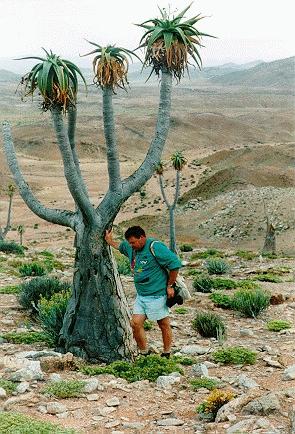Aloe pillansii
Aloe pillansii
Aloe pillansii is a plant of the genus of aloes in the subfamily Asphodelus ( Asphodeloideae ). The specific epithet honors pillansii the South African botanist Neville Stuart Pillans ( 1884-1964 ).
- 3.1 Literature
- 3.2 Notes and references
Description
Vegetative characteristics
Aloe pillansii grows forming stem and branches from about the middle dichotomy. The trunk reaches stature heights of up to 10 meters or more. He has at the base diameter of 1 to 2 feet and tapers upwards to about 20 centimeters. The smooth, lanceolate narrowed, gray-green to brownish- green leaves are slightly sickle-shaped and sit rosette together. The leaf blade is 50 to 60 inches long and 10 to 12 inches wide. The white leaf margins contain 1 to 2 millimeters big white teeth that are 5-8 millimeters apart.
Inflorescences and flowers
The to 50 times branched racemose inflorescence reaches a height of about 50 centimeters. The loose, cylindrical flower clusters are long and 15 centimeters and consist of about 30 individual flowers. The flower stems have a length of 10 millimeters. The yellow flowers are up to 35 millimeters long and narrowed at the base. The tepals are not attached to a length of 25 millimeters. The stamens and the style protrude 10 to 15 millimeters from the perianth.
Systematics, distribution and hazard
Aloe is pillansii in Namibia and South Africa's Northern Cape Province spread on hot, dry and rocky slopes. The first description by Louise Guthrie (1879-1966) was published in 1928. A synonym is Aloidendron pillansii ( L.Guthrie ) Klopper & Gideon F.Sm. ( 2013).
Aloe is pillansii out in Appendix I of the CITES Convention. In the Red List of Threatened Species IUCN, the type is known as " Critically Endangered (CR ) ', ie threatened with extinction, classified.









